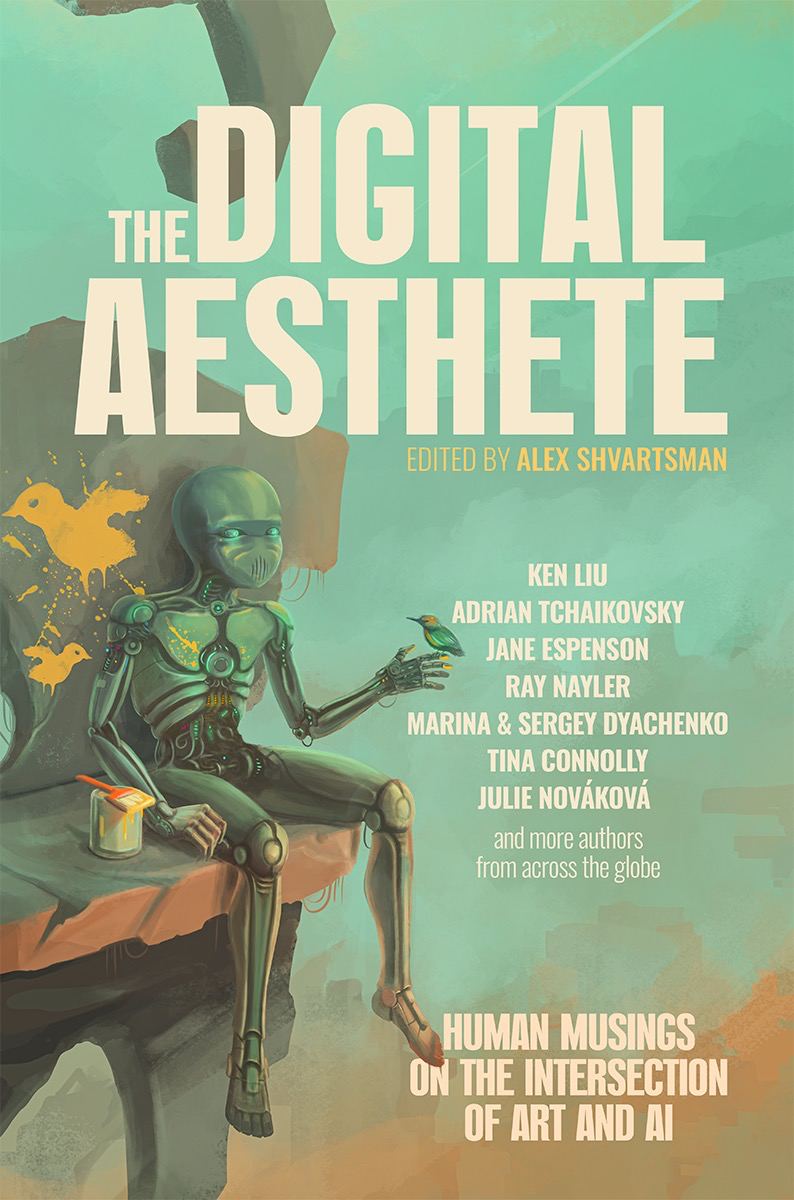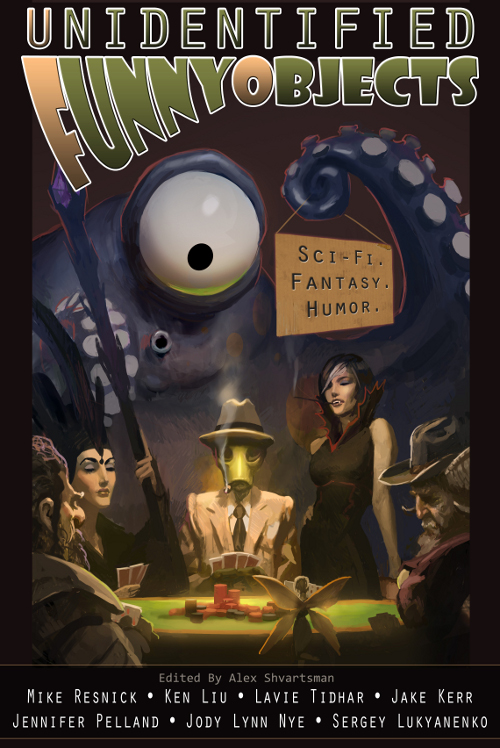“Welcome to weRobot,” said the chipper HR representative. “Jake and Ron and the rest of us are all so looking forward to your contributions!”
“Are you a true believer?” the woman next to me asked in a low, conspiratorial voice. I looked at her, puzzled; her name tag said Amy.
She took a sip of her coffee, frowned, and then rapped her knuckles against the conference room table. The little coffeemaker in the middle of the table, a retro-looking, squat, black cylinder with a chromed dome top, spun around until its single camera was aimed at Amy, who smiled and beckoned to it.
“A true believer in what?”
I whispered. I couldn’t help it. I knew I should be paying attention to the benefits presentation—Mom had emphasized no less than five times on the phone last night the importance of contributing to the 401(k) at my first job out of college. But I was feeling nervous (the slide on-screen at the moment actually said Our Impossible Mission), and Amy—forties, short-cropped hair, a tattoo of two fairies playing Nintendo on her left arm—looked like she had wisdom to share.
“The Myth of the Valley,” she said.
The coffeemaker rolled toward Amy, its motor humming softly. It stopped a few inches away and flashed the ring around its camera eye. Amy leaned forward to dump out the contents of her mug in the waste disposal chute at the side of the robot.
Then, instead of discreetly tapping out her new order on the touchscreen, Amy leaned back in her seat and said aloud, “Tea. Earl Grey. Hot.”
Some of the other new hires—almost all of them my age—looked at Amy disapprovingly for this interruption; a few others chuckled. “I’ve always wanted to do that,” said Amy, a satisfied grin on her face as the coffeemaker filled her mug with the new beverage.
Instead of acting annoyed, the HR rep smiled indulgently. “I was a fan, too. This is actually a perfect segue to the next slide.” She pressed the button on her clicker.
The new slide showed an old photograph of weRobot’s two founders, geeky college boys in their dorm room, surrounded by a mess of mechanical and electronic components as well as stacks of spiral-bound notebooks. “We believe that there’s no continuing mission more important than improving the lives of the human race through advancing robotics. We want every one of you to feel that you can make a difference, achieve what you thought was impossible, act like Jake and Ron when they started this company with a notebook full of diagrams that no one believed would work and eighty-five dollars between the two of them …”
Amy leaned over to me. “Either that’s a terribly staged photograph, or one of the duo is no good at programming.”
“Oh?”
“Look at that snippet of Perl on their computer. Reading all lines into an array? No chomp?”
I looked at the photograph and then back at her, my face blank.
“Not a coder then?”
I shook my head. “I majored in Folklore and Mythology.”
Amy gazed at me with interest. “I like this; we should talk more.”
Great, I don’t even get the engineering jokes. I suppressed a rising wave of panic and sought refuge in some homemade chicken soup for the soul.
One of the hottest companies in Silicon Valley wouldn’t have hired a liberal arts major without having seen something in me, right?
The HR rep took out a stack of notebooks and handed them out. “Your first and most important benefit!”
The notebooks turned out to be pads of graph paper. I flipped open mine. Instead of the standard square grid, the sheets were imprinted with unorthodox patterns like spirals, honeycombs, tessellations of animal shapes, a scattering of random dots.
“Don’t follow conventional wisdom,” said the HR rep. “If a problem hasn’t been solved, that means you are meant to solve it! Think impossible ... and then make it happen!”
“As corporate one-liners go, this one isn’t too bad,” whispered Amy. “Not as ripe for parody as Centillion’s ‘We arrange the world’s information to ennoble the human race,’ and certainly better than Bazaar’s shtick of having new employees build their own desks out of two-by-fours while chanting ‘There should be nothing you can’t buy from us!’ Look at all the eager beavers!”
I looked around at the others in my cohort. Some stared at their notepads, unsure what to do with the strange gift; others looked inspired and drew in them with intense concentration as though they were already designing weRobot’s next great hit.
Amy took another sip of her tea. “Youngsters are so fun to watch. They love to be inspired.”
“Do you think we’re just being fed some lines?” I asked. Amy’s wry tone had me concerned that I had made a mistake. “Glassdoor has really good reviews of this place’s culture.”
Amy chuckled. “Like all their competitors in the Valley, they’ve got the shuttle buses and free nuts and fruits and ToDoGenie credits, and I’m sure they’ll give you as much responsibility as you can handle, plus the stock options to keep you here. But no one really succeeds here without believing the One True Myth.”
“Making more money?” I was a little disappointed, to be honest. Amy sounded like a jaded cynic who believed all corporations were evil, and even I knew that wasn’t wisdom.
“Oh, the money is not what drives people like Jake and Ron,” Amy said. “The credo of the Valley is that all the world’s problems can be solved by a really smart geek with a keyboard and a soldering iron.”
I looked at Amy more critically: ShareAll backpack with a date from a decade ago, Centillion version 1.5 launch t-shirt, Abricot cell phone holder with their old logo. I had seen these as badges of honor, of her tours of service in the trenches of the greatest companies in the Valley, but maybe they were signs of something less admirable, a cynicism that was corrupting and made it impossible for her to fit in anywhere.
“What’s wrong with wanting to change the world?” I asked.
“Nothing, except a lack of humility,” Amy said.
“Well, I think it’s pretty cool that we’re finally making the future instead of just dreaming about it.”
I deliberately leaned a bit away from Amy. I didn’t need her negativity dragging me down on my first day. Besides, the HR rep was finally talking about the 401(k).
The team I was assigned to, Advanced Home Automation, had a vague mandate to create breakthrough products for the home, distinct from weRobot’s mainstay moneymakers: vacuum cleaners, laundry folders, and home security devices. Most of the engineers were veterans from other teams, and I got the distinct sense that many of them were here because they wanted to spend more time with their families and didn’t want to compete with the hungry twenty-somethings.
To my dismay, I found Amy assigned to my team as well.
“I’ve never worked with a folklore PM before,” she said.
“Building a product isn’t just about coding,” I said. “A PM’s job is to tell the story of the product.” I was grateful to the VP of Product Marketing for having used that line earlier on the baby PMs.
“No need to be defensive,” she said. “I think the Valley needs less techno-utopianism and more sense of history anyway. It will be fun to work together. For example, since you studied myths, I figured your deadlines will at least be less mythical. Darmok and Jalad on the ocean, amirite?”
I groaned inside. Great, she thinks I don’t know what I’m doing and she can just slack off. This assignment did not bode well for my career advancement.
I opened the graph paper notepad from earlier and printed across the top of the page: Advanced Home Automation. I underlined the words three times for emphasis, and then decided to erase the final n and rewrote it as a cursive tail that trailed to the edge of the page. This seemed to be a bolder statement than the original, a symbolic gesture at thinking outside the box.
But the rest of the page, blank except for the spiral grid, seemed to be a maze that mocked me.
“Did you sign up for the seminar from the research division?”
I turned around and saw Amy behind me, leaning against the wall of my cubicle with a fresh mug of tea.
“No,” I said, trying to look busy.
“Here’s a free tip: you don’t need to sit in your cubicle to get paid. They don’t take attendance here. Take advantage of that.”
I’d had enough. “Some of us like to get work done.”
Amy sighed. “WeRobot has some of the world’s most advanced researchers working for them—cognition, computation, anthropology, linguistics, nanomaterials—you name it. These free seminars are pretty much the best part of the benefits package.”
I pointedly said nothing and started to write on the notepad.
What are some unsolved problems in home automation?
“Kiteo, his eyes closed,” said Amy as she strolled away. “The lectures are probably too technical for liberal arts majors.”
It wasn’t until I saw the smirk on Amy’s face as I settled down in my seat near the entrance of the seminar room that I realized that I might have been manipulated.
Sitting by myself in my bedroom, I stared at the notes from the seminar and the pile of AI textbooks I had bought from Bazaar—I still preferred physical books to reading on-screen. Neural networks, cascading inputs, genetic algorithms... How was I ever going to make sense of all this stuff?
The diagrams I had copied from Dr. Vignor’s slides stared back at me as I struggled to remember why I had thought they were so exhilarating. Right then, they looked about as interesting as chess puzzles.
... the long tradition of behavior-based robotics took inspiration from research on insect behavior.
But why settle for inspiration when we can go directly to the source? Instead of programming our robots with simple algorithms that imitate the behavior of a foraging ant, why not imprint them with the neural patterns extracted from foraging ants? The new prototype robotic vacuum cleaner is able to cover a room in one-third the time of the previous model, and the efficiency improves over time as the machine learns which areas are likely to accumulate dirt and prioritize these areas...
“Eeek!” The scream came from the bathroom. Followed by the thud of the toilet seat cover. “Comeherecomeherecomehere!”
I grabbed the nearest weapon-like thing at hand—a heavy text book—and rushed into the bathroom, ready to do battle with whatever was threatening my roommate, Sophie.
I found her cowering in the bathtub and staring at the toilet, eyes wide with terror.
“What happened?”
“A rat! There’s a rat in the toilet!”
I put down the textbook, picked up the plunger, knelt down before the toilet, and pried open the seat cover just an inch so I could peek in. Yep, there was a rat in there all right, as big as my forearm. As I watched, it swam around the toilet leisurely, its beady eyes staring at me as though annoyed that I was interrupting its jacuzzi session.
“How did it get in there?” Sophie asked, her voice close to a shriek.
“I’ve studied the urban legends around rats in toilets,” I said. “There’s actually some truth to the stories.”
“Obviously!” Sophie said.
“Rats are good swimmers. We live on the first floor, and there’s not a lot of water in the trap to keep it out.”
“How can you stay so calm about this? What are we going to do?”
“It’s just an animal looking for food. Go get the dishwashing detergent, and we’ll flush this guy back where it came from.”
With her back pressed against the wall, Sophie gingerly stepped out of the bathtub and shuffled out of the bathroom to run to the kitchen. When she returned with the detergent, I propped up the lid again and squirted practically the whole bottle into the bowl.
“This makes everything slick and dissolves the oil on its fur so it can’t stay afloat as well,” I explained. I could hear the rat splashing in the water and scrabbling its claws against the porcelain in protest.
I flushed the toilet, and, even though I didn’t hear any more noises after the water swooshed away, I flushed it a couple more times for insurance. When I opened the lid again, the bowl was empty and squeaky clean.
“I’m going to call the landlord,” Sophie said, finally calming down.
I waved at her to be quiet. I had caught a glimpse of an idea, and I didn’t want it to be scared away.
Oh, how the engineers laughed at me. They sent me emails with rat jokes, rat cartoons, and a stuffed rat even appeared in my cubicle after lunch break.
“This is why we shouldn’t have non-technical PMs,” I heard one of them whisper to another.
In truth, I wasn’t sure they were wrong.
Amy came to visit.
“Save the rat jokes,” I said. “Not in the mood.”
“Me neither. I brought you some tea.”
Hot tea was indeed better than coffee for me in my jumpy state. We sat and chatted about her new house. She complained about having to clean the gutters as the fall deepened, and there was also all the money she had to pay to clean out the HVAC ducts and make sure the sewer pipes were free of roots. “There’s a lot of nooks and crannies in an old house,” she said. “Lots of places for critters to roam.”
“You’re the only one who’s been nice to me,” I said, feeling a bit guilty at how aloof I had been with her earlier.
She waved it away. “The engineers have a certain way of looking at the world. They are like the city mice who think the ability to steal cheese from a dinner table is the only skill that matters.”
“And I’m the country mouse who can’t tell a table apart from a chair.”
“I happen to enjoy new perspectives,” she said. “I didn’t start out as a coder either.”
“Oh?”
“I used to work at Bazaar as a warehouse packer. I had some ideas for how to improve the layout of the place to make shipping more efficient. They liked the ideas and put me in charge of solving other problems: cable management for their server rooms, access control for secure areas in the office, that sort of thing. Turned out I had a knack for technical puzzles, and I ended up learning to code even though I never went to college. This was before they required degrees for everything.”
So she’d been an outsider once, too. “I’m not sure I’ll ever fit in,” I said.
“Don’t think of it as fitting in. It’s… more about learning a culture, being comfortable with telling your story using their lore. The engineers will come around when you can paint them a vision they can understand. A map of the obstacle course to the new cheese outside, if you will, little country mouse.”
I laughed. “I’ve been trying. It’s hard, though; there’s so much to learn.”
“Why did you want to work in robotics anyway? I thought you liberal arts types just wanted to teach so you could stay in school forever.”
I thought about this. “It’s difficult to put into words. I’m fascinated by stories, the stories we tell each other and the stories we tell about ourselves. In our world, the stories that matter the most are all stories about technology. The dreams that move people today are all soldered and welded and animated by code, or they’re just spells operating in the ether. I wanted to have a part in these stories. I’m sorry, that’s probably not making much sense.”
“On the contrary,” she said. “That’s the most sensible thing I’ve heard from you. Technology is our poem, our ballad, our epic cycle. You may not be a coder, but you have a coder’s soul.”
It was possibly the oddest compliment I’d ever gotten, but I liked it. It was nice to have a friend.
After a moment, I asked, “Do you think my rat idea has a chance?”
“I don’t know,” she said. “I do know that if you are afraid of looking foolish, you’ll never look like a genius, either.”
“I thought you weren’t into inspirational quotes.”
“I might make fun of the myths of our corporate overlords a lot,” she said. “That doesn’t mean I don’t enjoy seeing a good tale play out. I’m still in the Valley, the biggest dream factory on earth, after all these years, aren’t I?”
Think impossible!
I decided to go straight to the source. Dr. Vignor listened to my presentation without saying a word, and then sat with his eyes closed for ten minutes, as though he had fallen asleep.
I couldn’t have been that boring, could I? I was miffed. I had worked hard on the slides, citing figures and papers—admittedly I didn’t understand everything I had read. And I thought the use of that animated clip art rat was particularly inspired.
“It’s worth a try,” he said, eyes still closed. “We’ve never worked with such an advanced animal, but why not? Everything’s impossible until we try.”
The next few months were a blur. Pushing a new product through weRobot was one of those experiences that transformed you. Design specifications turned into cobbled together proofs-of-concept turned into 3D-printed models turned into hand-crafted prototypes tethered to workstations running debug code. Engineers had to be herded and testers rallied and schedules drawn up and resources allocated. There were presentations to the sales staff and market research and the legal department and the supply chain.
I worked sixteen-hour days during the week—and only eight hours on the weekends because Amy had programmed my computer to lock me out if I stayed too long on Saturdays (“You need some non-work time to replenish your soul, kid. The River Temarc in winter. You don’t get the reference? Here, go watch these Star Trek DVDs”)—apologized to my sister and mother profusely for not being able to visit for their birthdays, and ignored texts and invitations from my non-work friends. I had to set an example for my team. How could I demand 100 percent of them if I didn’t do the same for myself?
The Rattus norvegicus is the most successful mammal on the planet (other than us). Since the European Middle Ages, the species has learned to live wherever we live, making their homes in our sewers, basements, attics, and subsisting on our food and heat. Some estimate that there are as many rats in the world as humans.
“We can’t use any of this,” said the guy from marketing. “We’re trying to get people to buy something instead of calling exterminators. What else have you got?”
Right, the key is to tell a good story. I flipped through more slides.
An adult rat is so flexible that it is able to squeeze through a hole the size of a quarter. It can swim for kilometers, even staying afloat for days in extreme circumstances. It is capable of scaling smooth, vertical poles as well as scurrying up the insides of pipes, and it is skilled at navigating the maze of ducts and conduits in human dwellings, its natural habitat.
I admired the resiliency and resourcefulness of the common rat. If they were corporate employees, they would certainly win the race.
“Let me chew on this some more—haha—and get back to you,” I told the marketing guy.
When you were working for the realization of a dream, work didn’t seem like work at all.
In the end, the official marketing literature explained that the Vegnor was named after Dr. Vignor, the world’s leading expert on non-behavioral robotics; a good origin story was critical to a superhero.
And we sold the Vegnor as a superhero for the busy homeowner.
Imprinted with the neural patterns of R. norvegicus, the sleek little robot, a ten-inch long segmented oblong form studded with advanced sensors and a Swiss Army knife’s worth of tools, was the modern incarnation of the hearth spirit. It could scurry up downspouts and clear accumulated leaves from gutters, saving homeowners from the dirty work and the danger of falling from ladders. It could swim through the plumbing, unclogging drains and pureeing any garbage with its swirling saw-blade teeth. The flexible body squeezed through tight turns and expanded to gain purchase against vertical tubing, allowing it to wander through ducts and conduits, cleaning away gunk and crud. It patrolled the sewer connection pipes, slicing apart tree roots and dislodging toilet paper wads. It knocked down ice dams in winters and cleaned out chimneys in summers, saving homeowners thousands of dollars a year in professional maintenance fees. It washed itself and charged itself. Best of all, it guarded a house against unwanted pests such as the common rat by emitting an annoying ultrasonic whine—and for those pests undeterred by such warning, it was capable of fighting them with gnashing teeth and glinting claws made of stainless steel.
The Vegnors flew off the shelves. Glowing reviews filled the web, and users on OurScreen posted videos of the antics of their beloved “Vegnies”—driving away snakes in Florida, crunching over scorpions in Arizona, making “speed runs” from one toilet to another in the house (to the delight of children and the befuddlement of their parents, and so this last behavior had to be patched away via an over-the-air update).
I received an invitation from Jake and Ron to attend the annual Fall Picnic held at their house. It was understood around the company that the only attendees were the top ninety-nine employees who embodied the “weRobot way.”
I had found my niche.
“Did you see the summary I sent you?” Amy asked.
“No. Yes. No.” I was distracted. There was so much to do once you had some success. “What are you talking about?”
“I’ve been looking at micro local trends generated by Centillion. Seems like there’s an uptick in searches related to exterminators around the country.”
“I’m done with rats,” I said. About thirty tabs were open in my browser, each loading a page with live sales numbers from different regions, and I clicked between them impatiently.
“Take a look at the list of zip codes with the highest increases in those searches. Do you see how they correlate with Vegnor sales?”
I hmm’d noncommittally.
“Are you even listening? You look like one of those rats addicted to pushing a button for a random food pellet.”
I looked at her, offended. “The Vegnor is selling well. I have to finish this after-action review.”
She rolled her eyes. “That’s just corporate nonsense. Changing the world doesn’t stop with making a sale. There’s a mystery here. A story.”
“Customers are giving plenty of feedback online. Overwhelmingly positive.”
“Just like you can’t rely on customers to tell you what they want when they haven’t seen it, you also can’t rely on them to tell you what’s wrong when they haven’t figured it out.”
I waved away this koan. There were always more mysteries than there were hours in the day—and I didn’t have the techie disease of going down the irrelevant rabbit holes posed by random puzzles that had no relationship to the goal. I needed to summarize my experience on Vegnor into a process that could be repeated so that I could come up with something else to top the Vegnor. In a place like weRobot, you were only as good as your next project. PMs who rested on their laurels didn’t get invited to the next Fall Picnic.
Amy was about to speak again when an email alert dinged on my computer.
“Sorry, I have to get this.” Almost compulsively, I clicked over to the tab. I was feeling irritable these days, hoping each email would be from someone important in the company inviting me to join a team with more prestige, closer to Jake and Ron.
Wait, I chided myself. I meant a team with projects that made a bigger impact on people’s lives, right? Am I more interested in climbing the corporate ladder or changing the world? Is there a difference?
The email turned out to be from my sister, Emily. All her emails these days contained pictures of her new baby. Sure, I loved my nephew, but he couldn’t even talk, and I was sick of watching another video of him rolling around on the floor for “tummy time.” Parents were the most boring creatures on earth.
... Danny won’t sleep ... I think I’m going slowly insane. I can’t even hear myself think. I’ll pay anything ...
“... are you going to investigate the correlations? Aren’t you even a little bit curious?”
I looked up. Somehow Amy was still standing there, babbling about something. “Isn’t there some seminar you need to get to?” I asked pointedly.
She shook her head and threw up her hands in an I give up gesture. “Chenza at court, the court of silence,” she muttered as she moved away.
I felt bad that she was feeling rejected. But I wasn’t a cynical engineer too jaded to feel the thrill of changing the world. I had been to the Fall Picnic, damn it. I had a purpose.
There were close to forty-five million children under the age of twelve in the United States. Demographic trends and migration patterns and immigration laws and regulatory pressure added to a situation where an increasing number of parents were without access to affordable, high-quality, and trusted childcare. People were working longer hours and working harder, leaving less time and energy for their children.
Big data analytics backed up my hunch. WeRobot’s web spiders crawled through parenting forums and social networks and anonymous confessplaint apps and crunched the mood and emotional content of posts by parents of young children. The dominant note was a sense of exhaustion, of guilt, of worry that they weren’t doing a good job as mothers and fathers. There was little faith in daycare centers and in-home help—parents didn’t trust strangers, and yet they simply couldn’t do everything themselves.
It was the ultimate opportunity for a labor-saving device. What if the drudgery of parenting—the midnight feedings, the diaper changes, the perpetual and endless cleaning and picking up and laundry runs, the tantrums, the sicknesses, the monitoring and measuring mandated by pediatricians, the meting out of discipline and punishment—all could be taken care of by a perfect nanny, leaving parents only the joy of true quality time with their offspring?
“You’ve been reading that email for ten minutes,” Amy said. “That’s never a good sign.”
I had read the email so many times that the words no longer made sense. But really, all the verbiage on the screen could be reduced to a single word.
“They said no.”
To her credit, Amy said nothing. She went away and came back a few minutes later with a mug of tea and set it down on my desk. I picked it up, comforted by the warmth.
“I brought you a gift, too,” she said. “I was going to give it to you when Vegnor launched, but it took longer to get ready than I anticipated—typical engineering scheduling, you know. Figure you could use a bit of cheering up.”
She whistled, and a sleek Vegnor, painted black, slinked into view from beyond the cubicle wall.
“This is no ordinary Vegnie,” she said. “I’ve re-programmed it to be the ultimate office prankster. You can tell it to squirt hot sauce in the coffee of the marketing department or tell lawyer jokes from behind the HVAC grille in the legal group. Heck, you can even get it to steal the lunch of whichever VP just told you no. But you have to learn to speak its language.”
She bent down to the little mechanical rat. “Bigwig, standing on Watership Down with ears plugged.” She frowned in a pretty good impression of the VP of Product Marketing. Then she turned to me, “Want to try?”
I looked at the rat, pointed at Amy and then myself. “Darmok and Jalad, at Tanagra”—Amy smiled—“Vegnie, the cheese of the Bigwig in the Labyrinth of Knossos.”
The little rat chirped and scuttled away.
I clapped my hands. “That is inspired.”
“I should know learning to speak Tamarian is easy for a Folk and Myth major.”
When we finally finished giggling, I said, “I don’t understand why they didn’t approve my project. Given my track record on Vegnor, they should have more trust in me.”
“It’s not a matter of trust. The problem you’re proposing to solve is too hard. People can’t even agree on the best way to sleep train a baby. How do you propose to make the perfect substitute parent?”
“That’s just the result of overthinking. People don’t know what they want until you show it to them.”
“You’re too young to understand that you should never give parenting advice.”
“You’re too cynical. Even if there isn’t a single right answer for something, we can always make it into a user-accessible setting.”
Amy shook her head. “This isn’t like designing a robot to clean the gutters. You’re talking about raising other people’s children. The liability issues alone will make everyone in Legal faint.”
“You can’t let lawyers run a company,” I said. “Isn’t weRobot about thinking impossible? There’s always a solution.”
“Maybe you should create an island where there are no rules so you can experiment with technical solutions to all life’s problems to your heart’s content.”
“That would be nice,” I muttered.
“You’re scaring me, kid.”
I didn’t answer.
Jake and Ron had always prided themselves on maintaining an entrepreneurial spirit in weRobot even as it grew to thousands of employees. Those who got invited to the Fall Picnic were expected to get things done, not wait for orders.
So I did the natural thing: telling my team that my proposal had been approved.
The next step was to recruit Dr. Vignor to the effort.
“That’s a very difficult challenge,” he said.
“You’re right,” I said. “Probably much too hard. I’ll file it away until we have the brain power.”
He came to find me that afternoon, begging to be allowed to be on the team. See, the right story is everything.
We started by gathering manuals on childcare and running them through the semantic abstracter for fundamental rules of good parenting.
That … turned out to be a hopeless task. The manuals were about as consistent as fashion advice: for every book that advocated one approach, there were two books that argued that particular approach was literally the worst thing that one could do. Should babies be swaddled? How often should they be held? Should you let them cry for a few minutes and learn to self-soothe or comfort them as soon as they started to fuss? There was no consensus on anything.
The academic literature was no more illuminating. Child psychology experts conducted studies that proved everything and nothing, and meta studies showed that most of them could not even be replicated.
The science of child rearing was literally in the dark ages.
But then, while flipping through the TV channels late at night, I stopped at a nature program: The World’s Best Mothers.
Of course, I cursed myself for my stupidity. Parenting was a solved problem in nature. Once again, the modern neurosis of overthinking had created the illusion of impossibility. Billions of years of evolution had given us the rules that we should be following. We just had to imitate nature.
Since academics had proven basically useless on this subject, in order to find my model, I turned to that ultimate fount of wisdom: the web. Every Mother’s Day and Father’s Day, every eyeballs-hungry site seemed to publish listicles that purported to describe the animals that qualified as the world’s best mothers and fathers.
There was the orangutan, whose baby clings to the mother continuously for the first few years of its life.
There was the deep sea octopus, Graneledone boreopacifica, who did nothing but guard her eggs for four and a half years—not even eating—until they hatched.
There was the elephant, who, besides a long gestational period, engaged in extensive alloparenting as members of the herd all participated to raise the babies.
And so on and so forth…
… and putting them together, I had my story: the paragon of parenting, the essence of bottled love.
I would replicate the self-sacrificing, participatory alloparenting groups of nature with robots. Busy modern urban parents didn’t know their neighbors and lived away from extended family, but a network of weRobot devices would be almost as good. Our robotic vacuums, laundry folders, and Vegnors could all pitch in to keep the customers’ children safe and act as playmates—incidentally, this also encouraged customers to purchase more weRobot devices, which was always a good thing. Devices from neighboring residences could also collaborate to watch over both households’ children even without the parents being best friends—trust was ensured by the standardization of weRobot algorithms. The proprietary local area wireless network substituted for nonexistent or fraying social bonds.
“Mary Poppins,” I vowed, “with her umbrella open!”
Dr. Vignor modeled the neural patterns driving the behaviors of dozens of animals judged to be good parents by the wisdom of the web, and after extensive software emulation, it was time to test the first prototypes.
I posted the call for volunteers on weRobot’s internal network, and to my surprise and puzzlement, there weren’t nearly as many takers as I had hoped.
“There aren’t that many parents working here,” Amy said when I complained to her. “That’s not exactly a secret about this place. Look at the schedule you’re keeping. It’s not very compatible with starting a family, is it?”
“Even more evidence that there’s a market for this product!” I said. The key to dreaming the impossible was to see opportunities where others saw only problems. “Just think of all the lost productivity due to parents not being able to devote as much time and energy to their careers because they have to run home to deal with their offspring.” I was practically rubbing my hands in glee. “Marketing should be able to hint at this subtly in the TV ads. Power couples who spend less time parenting than they do at the gym ought to make a striking addition to the value proposition.”
“Did you just use the phrase ‘lost productivity’ non-ironically?” Amy asked, shaking her head. “And ‘value proposition’?”
Since there weren’t enough internal volunteers, I had to expand the beta testing program by asking my team to recruit friends and family.
I found a super scary NDA for some other weRobot project on the corporate intranet—the lawyers were good for something after all—and a few search-and-replace macros later, I had a way to ensure that no one would leak any information to competitors or the luddite press, which was always sniffing for news about upcoming tech products that they could exaggerate into dystopian visions to sell the papers.
Emily enthused to me about the new addition to her family.
“It’s incredible!” she gushed on the phone. “I’ve never seen Danny so well-behaved. Para changes him and feeds him and rocks him to sleep, and he loves it! Eric and I are finally able to get a good night’s sleep. Everyone at work has been begging me for the number of the au pair agency I’m using.”
I beamed with pride. Para was a marvel of engineering. The body-temperature, medical-grade synthskin and the oscillator thumping at the rhythm of heartbeat were designed to calm newborns. The robot’s eight arms, made of a series of elastic actuators for safety, and precision manipulators allowed the machine to handle delicate childcare tasks with aplomb: it could change a diaper, feed, powder, massage, tickle, and give a bath using power-delivery curves that provided maximum physical comfort to the baby, all while humming a pleasant, soft song, folding laundry, and picking up dropped toys with its extra arms.
But the crowning achievement of Para, of course, was its neural programming. Para was the perfect parent-surrogate. It never got tired or bored; it never stopped giving the baby 100 percent of its attention; it was equipped with eons of evolutionary instinct drawn from the animal kingdom judged to suit human needs: it would protect the baby at all costs and was capable of reacting to save the child from any and all emergencies.
“I’m enjoying my time with Danny so much more now. I feel calmer, more patient, and I get to give my attention to all the fun parts of being a parent. It’s incredible.”
“I’m really glad,” I said to my sister. I felt like a wreck. I had pushed my team to the limit, and hearing my sister being so pleased made all the hard work worth it.
Monday morning, my phone buzzed as I rode on the work shuttle. My heart clenched and then beat wildly as I read the text.
Why are Jake and Ron summoning me? There was only one answer: my skunkworks project had been discovered.
The tests with Para weren’t anywhere near done. I still needed more time to produce convincing data to guarantee forgiveness.
With great trepidation, I showed up at the Presidents’ Office on the second floor of the central building. The executive assistants quickly ushered me into a small conference room, where Ron and Jake sat at the table, stone-faced.
“I can explain,” I began. “The preliminary results are very encouraging—”
“I hardly think we’re in the preliminary phase anymore,” Jake interrupted. He slid a tablet across the table. “Have you read this?”
It was the New York Times. “Home Robots Found to Be Source of Infestations,” said the headline.
I quickly scanned through the article, and my heart sank. I should have paid more attention to those reports Amy had been sending me.
It turned out that the Vegnors were so good at their jobs that they were displacing real rats. The robots were, of course, programmed to fight the rats and chase them out of homes—this was touted as one of the key advantages of the machines.
Then the Vegnors replicated some of the beneficial behaviors of the rats by sweeping and collecting food and garbage from the plumbing and pipes. I had been particularly proud of this clever bit of biomimicry. I thought I was being comprehensive.
But the Vegnors only pushed the garbage away from the houses instead of eating it, which led to middens on the edges of properties that became breeding grounds for other vermin—cockroaches, maggots, fruit flies—and the cockroaches infested the houses because they were now free of rats, which had once preyed on them. Even worse, the bodies of the rats the Vegnors killed attracted coyotes, the top urban predator in many American cities.
Everyone had always thought that if all the rats in the world died tomorrow, no one would miss them. Apparently they had a role to play in the urban ecology that the Vegnors could not fully replicate.
“Our neighbors came to complain this morning,” said Jake. “They have outdoor cats.”
I imagined the bloody, lifeless body of Tabby, the victim of a coyote. I winced.
“And they dragged us out to the wall between our properties so they could show us the dumping ground of our Vegnor,” said Ron. “The smell made me lose my breakfast.”
“There’s going to be a class action lawsuit,” said Jake, rubbing his temples.
“You see how gleeful the plumbers and exterminators quoted in that article are?” said Ron, drumming his fingers on the table. “The Vegnors were supposed to make them no longer necessary, but our robo-rats have been creating infestations wherever they go.”
I struggled to not hyperventilate. They don’t know about the skunkworks project. My eyes looked from Ron to Jake and then back to Ron again.
“We could make a patch,” I blurted out, “and get the Vegnors to collect the garbage and dispose of it safely … Or, we could make another robot to clean up the mess and sell them to municipal governments ... Or how about we patch the Vegnors to seek out cockroaches, and their eggs too? … ”
If technology created a problem, surely the best solution was more technology.
Ron and Jake just glared at me.
The Vegnor setback meant that I had to hit Para out of the park. It was the only way to redeem my name.
While doing my best to manage the robo-rat fallout, I pushed my team and myself even harder in an effort to make the Para prototypes do more for the parents. We wanted to anticipate needs and take care of them all: the Paras could be set to implement a clock-based feeding regimen, or, in the alternative, an infant-driven feeding schedule that replicated breastfeeding; they could be configured to start sleep training at an age designated by the parents, or encourage babies to engage in the “paleo” practice of polyphasic sleep; they could be designated to play and comfort children in a variety of styles to stimulate optimal brain development; and they could even cook meals and do simple housekeeping to give exhausted parents more time to sleep and finish their work until they were ready for their offspring.
The preliminary results were promising. The feedback from the new parents was almost uniformly positive.
These robots were as devoted as the octopus, as cooperative as the elephant, as responsible as the orangutan — they really were the best nannies the parents could ever hope for. They freed moms and dads from everything unpleasant about parenting and left them only the fun parts.
“Why don’t you want it?” I asked. “What did it do wrong?”
“Nothing!” said Emily. “But it doesn’t feel right.”
“I can fly down tonight to see—”
“I see. You can’t fly down here for my birthday, but you can come on a night’s notice when you think something’s wrong with your robot.”
I took a deep breath. “That’s not fair, Emily.”
“Isn’t it? Since when did you become such a workaholic?”
“Don’t do this to me, Em. It’s my career we’re talking about here! If I can’t trust you to give me honest feedback, who can I trust?”
Emily sighed on the other end of the line. “I’m telling you the truth. There’s nothing wrong with what Para is doing. But Eric and I don’t like what it’s doing to us.”
“How do you mean?”
This shouldn’t have happened. I had been careful from the very beginning of the Para project to avoid one of the big pitfalls with human nannies, who often elicited jealousy from parents seized by the fear that their children were building a stronger bond with the nanny than with them. This was one of the reasons that Para was not designed to be humanoid. Just as we didn’t feel threatened by the housekeeping skills of automated labor-saving devices, no parent needed to worry that their child would become attached to a synthetic appliance, not fundamentally different from a self-rocking cradle.
“I don’t know how to explain it.” Emily sounded like she was grasping for words. “But Eric was telling me that he missed how much time he used to spend with Danny, and I feel the same way.”
“But so much of that was wasted time. Para allows you to spend quality time, to be efficient.” The frustrated emails that Emily used to send me went through my mind, as did the words of so many other surveyed mothers and fathers who complained about lack of sleep, about how their babies turned their thoughts to mush. Children took up too much time—that was the problem to be solved.
“That’s just it. I’m not sure there is such a thing as ‘quality’ time. Eric and I used to spend hours feeding Danny and worrying about his poop and trying to get him to sleep, and we felt tired and unprepared and stupid, but every time we looked into Danny’s eyes, we felt happy. Now we pretty much just spend half an hour a day reading to him and playing with him, but even that seems too much. We get impatient. Somehow, the less time we spend with Danny, the less time we want to spend with him. This doesn’t feel right.”
Daedalus, watching the wings melt.
…the amygdala, hypothalamus, prefrontal cortex, and olfactory bulb are all activated by infant behavioral cues, which trigger adjustments in the levels of hormones such as oxytocin, glucocorticoids, estrogen, testosterone, and prolactin for the maintenance of parenting patterns…
I closed the textbook and rubbed my temples.
The sleep deprivation, the anxiety from the infant’s cries, the constant worry that something so fragile and so demanding depended on you—the experience of being new parents changed people, altered the chemical composition of their blood, rewired their brains.
There was no such thing as quality time because there were no shortcuts. The very experience that bonded new parents to their children required the investment of time and energy to change them, just as their babies needed time and energy to grow.
The tedium and anxiety were inseparable from the rewards.
It was not possible to reduce parenting down to “quality time” and to outsource the difficult parts to robots—for some, perhaps most, parents, the physical and neurological changes brought about by becoming a parent were desirable.
Really, I should have known better. Would I give up the sleepless nights and the tedious days of trying out hundreds of failed solutions in the struggle toward a successful, shipping product? The painful process was what made the victory sweet, changed me as a person, made the impossible dreams real.
“Are you leaving or are you being fired?” asked Amy, handing me a mug of tea. “I made you the good stuff. The robots here ruin good tea with tepid water.”
My skunkworks project had been shut down. Once I understood that Para had no future, there was little choice but to come clean. I had cost the company a lot of money and taken on unacceptable risks. I should have been fired.
“Neither,” I said, accepting the mug gratefully. “I’m being transferred to a new division.”
Amy lifted an eyebrow.
“It doesn’t have a name yet,” I said.
“What … will you be doing?”
“Shaka, when the walls fell,” I said.
After a moment, Amy smiled. “Ah, I see. The Unknown Unknowns.”
“That’s one possible name,” I said. “Or maybe the Division of Country Mice.”
We laughed.
Ron and Jake had decided that it was important to have a group focused on fresh perspectives. Staffed with artists, ecologists, ethicists, anthropologists, cultural critics, environmentalists, and other non-roboticists, our job would be keeping an eye on the blind spots of technical solutions. We would critique products for unanticipated consequences, gather data to detect non-obvious evidence of failure (like those searches for exterminators), and generally act as a kind of corporate source of pessimism to counterbalance the over-exuberance of the engineering staff. Having become a byword for failure at weRobot, who was better qualified to join the group than me?
“Thanks for taking over the rehabilitation projects,” I said.
She waved her hand dismissively. “I’ve always been good at cleaning up after other engineers, probably because I never think anything is going to work in the first place. But I’ll enjoy fixing your robot rats. They’re cute.”
“I really made a mess of things, didn’t I?”
“Not entirely,” said Amy. She proceeded to explain to me that with Ron and Jake’s blessing, she was going to repurpose the hardware and software of Para for a much less ambitious version that would try to help overworked mothers and fathers rather than supplant them. Instead of yielding to the myth of quality time, the robots would be more cooperative, doing only what parents wanted them to do, and always ready to step back. Some advocacy groups for mothers suffering from postpartum depression had expressed interest in such a project as part of a comprehensive treatment plan.
“You had the right ideas, kid,” she said. “Sometimes you step out too far and fall off the edge, but how else would you know how far you can go?”
“That sounds almost like the One True Myth.”
“I’m a skeptical believer. Technology is beautiful, but it’s the nature of technology to create more problems to be solved. Machines, like rats, are a part of nature, and our lives are embedded within each other. Hephaestus, his hammer raised.”
“That reminds me,” I said. “I’ll need you to come by my office next week.”
“What for?”
“We are going to do a brain dump with you—”
“That’s impossible—”
“I didn’t mean literally! Besides, how do we know it’s impossible if we don’t try?”
I couldn’t keep a straight face long enough to fool her. But I could tell she came this close to falling for it.
“I’m not going to be scanned into a robot,” she said.
“I want you to come and tell some stories, infect everyone with a bit of your cynicism. I think that’s going to be really useful.” Amy nodded. “Gimli, his ax ready.”











